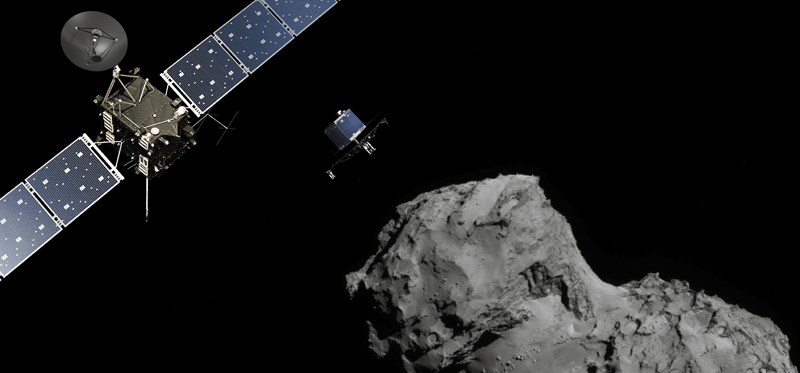Rosetta on the point of ending its mission

On the upcoming 30 September the European Rosetta spacecraft will complete its mission with a controlled descent onto the surface of the comet 67P/Churyumov–Gerasimenko. This denouement is the result of the spacecraft’s increasing distance from sun and earth, meaning it loses energy and bandwidth, and also the ageing of both spacecraft itself and payload, which have had to endure a harsh environment now for over 12 years.
Unlike events in 2011, when Rosetta was put into a 31-month deep-space slumber on the most distant part of its trajectory, this time the spacecraft is moving parallel to the comet. The maximum distance of the comet 67P/Churyumov-Gerasimenko from the sun (over 850 million kilometers) is the furthest that Rosetta has ever traveled. In this most distant point the probe lacks enough energy to guarantee that its heaters can achieve a survival-compatible temperature and it would also lose the bandwidth necessary for sending scientific data.
Instead of risking a much longer slumber period, from which it would be unlikely to awake, the head scientists put their heads together in 2014 and decided that the mothership would follow the landing module Philae down to the comet’s surface.
Communications will cease once the mothership touches down. In August, in preparation for its great showdown, Rosetta’s operators will begin to tweak its trajectory, bringing it closer to the comet by means of a series of elliptical orbits. The final hours of this descent will allow Rosetta to make unique measurements, including very-high resolution images that will boost the mission’s returns with data that can be culled only in a final phase like this one. On 30 September all spacecraft operations will cease; from this moment on teams will begin to concentrate solely on scientific questions.
GMV has played a key role in the Rosetta mission from the word go. Both the entry into orbit and the landing of a soft-touchdown lander (Philae) on comet 67P/Churyumov-Gerasimenko were controlled from Earth by a team of engineers, with a crucial role being played by GMV. The company sent some of its staff to the Rosetta Science Operations Centre within the European Space Agency’s European Space Astronomy Centre (ESAC/ESA) in Villafranca del Castillo (Madrid), to ESA’s European Space Operations Centre (ESOC) in Darmstadt, Germany, and to the Control Center of the French Space Agency (Centre National d'Etudes Spatiales: CNES) in Toulouse, France.
GMV also played a key role in the initial mission analysis stage since years before the actual launch. Among other activities it also participated in the planning of scientific operations, planning control of three instruments and preparation of the operations for the main mission phase (the comet phase).
GMV personnel posted to France performed maintenance of the calculation tools used by CNES’s control center to calculate necessary illumination and visibility criteria to decide the comet landing point and also the possible descent trajectories of the Philae soft touchdown lander.
GMV’s personnel posted to Germany, for their part, have been participating since 2004 in flight dynamics operations, specifically trajectory control and generation of the necessary commands for controlling the probe’s orbit and attitude. For comet approach operations GMV’s flight dynamics team are carrying out additional tasks: design of approach-, orbit- and descent-trajectories; processing of images from Rosetta’s onboard cameras and estimating the comet’s navigation-affecting characteristics. GMV’s personnel will be carrying out this series of activities until right up to the end of the spacecraft’s operations.